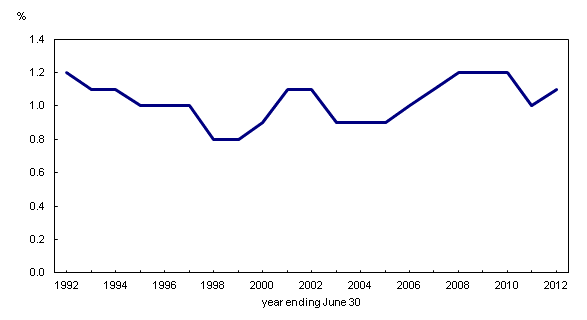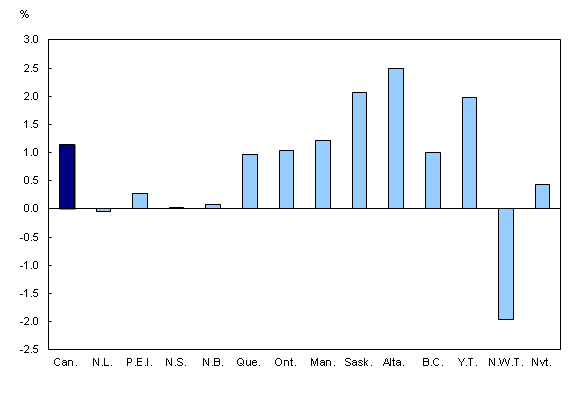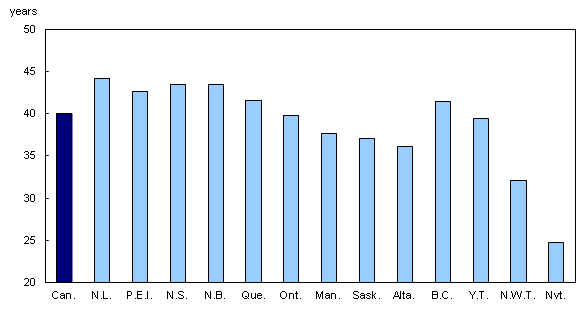Canada's population estimates: Age and sex, July 1, 2012
Archived Content
Information identified as archived is provided for reference, research or recordkeeping purposes. It is not subject to the Government of Canada Web Standards and has not been altered or updated since it was archived. Please "contact us" to request a format other than those available.
Related subjects
-
[an error occurred while processing this directive]
As of July 1, 2012, Canada's population was estimated at 34,880,500, an increase of 396,500 or 1.1% from the same date in 2011.
This was slightly higher than what was observed in the previous year (+1.0%) and was similar to the average growth rate of the past 20 years.
Canada's annual growth rate in 2011/2012 was the highest among G8 countries for the same period. Other G8 rates ranged from a decline of 0.3% (Japan) to an increase of 0.7% (United States).
Net international migration has been the main source of population growth for Canada since 1993/1994. For the year ending June 30, 2012, net international migration represented two-thirds of the country's population growth.
Demographic growth rate, Canada, year ending June 30

Chart description: Demographic growth rate, Canada, year ending June 30
Population growth higher on the Prairies
Overall, demographic growth in 2011/2012 was lower in the Atlantic provinces and higher in the Prairie provinces.
Growth rates exceeded the national average of 1.1% in Alberta (+2.5%), Saskatchewan (+2.1%), Yukon (+2.0%) and Manitoba (+1.2%).
Demographic growth rate by province and territory, Canada, year ended June 30, 2012

Nunavut (+2.0%) had the country's highest rate of natural increase in 2011/2012. Among the provinces, the highest rate occurred in Alberta (+0.8%), which has been the case since 1980/1981.
In terms of international migration, Saskatchewan (+1.3%) had the strongest growth. Other provinces with international migration growth above the national average of 0.8% were Prince Edward Island (+1.1%), Manitoba (+1.1%) and Alberta (+1.0%).
For provinces and territories, demographic growth was the result not only of natural increase and net international migration, but also of net interprovincial migration. The population of two provinces – Alberta and Saskatchewan – increased as a result of interprovincial migration. Alberta had a net inflow of 28,200 (+0.7%) and Saskatchewan, a net inflow of 2,800 (+0.3%). On the other hand, Prince Edward Island (-0.9%) had the highest rate of net outflow among the provinces.
Population continuing to age
As of July 1, 2012, the median age of the Canadian population was 40.0 years. That is, half of the population was older and half younger. In the past 20 years, that is between 1992 and 2012, the median age in Canada has increased by 6.4 years.
The median age in 2012 was still higher for women (41.0 years) than men (39.0 years). This difference is largely explained by a persistent, although diminishing, gap in life expectancy in favor of women.
The number of children aged 14 and under was estimated at 5,663,200. They represented 16.2% of the total population, down from 20.7% in 1992.
The number of seniors aged 65 or older was estimated at 5,186,800. They represented 14.9% of the total population, up from 11.6% in 1992. The proportion of seniors will grow rapidly in the coming years as baby boomers reach the age of 65.
The number of seniors is approaching the number of children. Between 1992 and 2012, the number of seniors increased 57.6%, while the number of children fell 3.6%. As a result, on July 1, 2012, children outnumbered seniors by 476,300, compared with close to 2.6 million on the same date in 1992.
Regional differences in age structure
Overall, the nation's youngest populations are found in the territories, more specifically in Nunavut and the Northwest Territories, and the oldest in the Atlantic provinces. This trend has remained steady for several years and is the result of regional differences in demographic behaviours.
As of July 1, 2012, Newfoundland and Labrador had the highest median age in the country at 44.2 years.
Median age by province and territory, Canada, July 1, 2012

Chart description: Median age by province and territory, Canada, July 1, 2012
Although it is also ageing, the youngest population was in Nunavut, where the median was 24.7 years. This was mainly the result of a higher fertility rate combined with a lower life expectancy.
The median age in Alberta was 36.1 years on July 1, 2012, the lowest among the provinces.
Note to readers
Estimates in this release are based on 2006 Census counts adjusted for census net undercoverage to which is added the estimated demographic growth from May 16, 2006 to June 30, 2012.
The 2011 Census population counts were released on February 8, 2012. Population estimates based on the 2011 Census counts, adjusted for census net undercoverage, will be available in September 2013 for provinces and territories and in February 2014 for sub-provincial areas.
This release mainly focuses on preliminary postcensal population estimates by age and sex as of July 1, 2012. The estimates presented in this release are subject to revision. Future updates could affect the analysis of trends.
Unless otherwise stated, historical comparisons in this analysis relate to the period between July 1, 1971 and July 1, 2012, the period covered by the current system of demographic accounts.
Natural increase is the change in population size over a given period as a result of the difference between the number of births and the number of deaths.
Net international migration is the change in population size over a given period as a result of movements of population between Canada and other countries that involve a change in the usual place of residence. A distinction is made between immigrants, emigrants, returning emigrants, net temporary emigrants and net non-permanent residents.
Non-permanent residents (also called temporary residents) are people from another country who have a work or study permit, or who are refugee claimants, and family members living in Canada with them.
Median age is the age at which 50% of the population is older and 50% is younger.
Available without charge in CANSIM: tables CANSIM table051-0001, CANSIM table051-0002, CANSIM table051-0004, CANSIM table051-0005, CANSIM table051-0011 to 051-0013, CANSIM table051-0018, CANSIM table051-0019 and CANSIM table051-0041.
Definitions, data sources and methods: survey number survey number3604.
The Annual Demographic Estimates: Canada, Provinces and Territories, 2012 (Catalogue number91-215-X, free), is now available from the Key resource module of our website under Publications.
For more information, or to enquire about the concepts, methods or data quality of this release, contact Statistics Canada's National Contact Centre (toll-free 1-800-263-1136; 613-951-8116; infostats@statcan.gc.ca) or the Media Hotline (613-951-4636; statcan.mediahotline-ligneinfomedias.statcan@canada.ca).
- Date modified:
